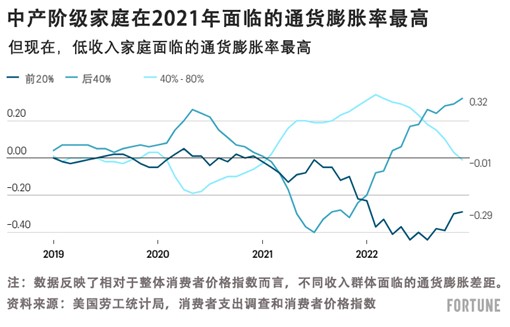
在过去几年中,由于持续的高通胀,二手车、燃料和许多消费品的价格上涨,但并不是所有美国家庭都受到了同样的冲击。
纽约联邦储备银行周三发布的研究显示,从2021年初到2022年6月,非裔、西班牙裔和中产阶级家庭受到物价飙升的冲击最大。
但在过去六个月里,在研究人员分析的所有群体中,美国农村地区的通货膨胀率可能是最高的。这在很大程度上是因为美国农村地区非常依赖汽车和燃料。在通货膨胀的高峰期,生活在小城镇和农村社区的美国人面临的通货膨胀率至少比全国平均水平高出2%。
尽管美国劳工统计局(Bureau of Labor Statistics)跟踪通胀,但它没有跟踪通胀给不同人口结构带来的影响。为了了解物价上涨如何影响美国人,纽约联邦储备银行的研究人员必须分析消费者价格指数中不同商品和服务的具体消费份额以及产品通胀系列。
纽约联邦储备银行的研究人员称,2021年6月,对西班牙裔美国人来说,通胀率比全国平均水平高出近1.5个百分点。对非裔家庭来说,通胀率比全国平均水平高出约1个百分点。作为参考,根据消费者价格指数,2021年6月的年通胀率跃升至5.4%。
对美国中产阶级而言,通货膨胀从2021年春季开始加剧,并扩大了经济差距,这主要与汽油和汽车价格的飙升有关。事实上,研究人员发现,汽油和汽车价格大幅上涨,尤其是二手车价格大幅上涨,对包括年龄和地理位置在内的许多人口统计数据中由通胀驱动的经济差异产生了巨大影响。
少数族裔和中产阶级家庭受到的冲击最大,但随着通胀在2022年底开始降温,特别是在交通成本方面,通胀给少数族裔和中产阶级家庭带来的影响也有所缓解。

纽约联邦储备银行的研究人员发现,截至2022年12月,对西班牙裔家庭来说,通货膨胀率仅比全国平均水平高出0.27个百分点。12月,年通胀率为6.5%。对非裔家庭来说,通货膨胀目前低于全国平均水平。
但随着交通运输通胀趋于平稳,在比较不同收入等级时发现,美国中产阶级受到通胀的冲击最大,这种趋势已经出现逆转。据纽约联邦储备银行的研究人员称,截至2022年12月,现在对低收入家庭来说,通货膨胀率最高。
不同收入群体之间的通胀差异远远小于不同种族和民族群体之间的通胀差异。但中等收入家庭实际上比低收入家庭经历了高得多的通胀水平,这一事实与之前的研究大相径庭。此前的研究通常认为,物价上涨通常对较贫困的美国人冲击最大。
即便如此,研究人员表示,考虑到最近一段时间的通胀是由一小部分商品推高的,特别是与交通运输相关的产品,如二手车和燃料,这是有道理的。因此,那些每月预算中交通费占很高比例的人,包括美国中产阶级和农村家庭,受到的冲击更大。(财富中文网)
译者:中慧言-王芳
在过去几年中,由于持续的高通胀,二手车、燃料和许多消费品的价格上涨,但并不是所有美国家庭都受到了同样的冲击。
纽约联邦储备银行周三发布的研究显示,从2021年初到2022年6月,非裔、西班牙裔和中产阶级家庭受到物价飙升的冲击最大。
但在过去六个月里,在研究人员分析的所有群体中,美国农村地区的通货膨胀率可能是最高的。这在很大程度上是因为美国农村地区非常依赖汽车和燃料。在通货膨胀的高峰期,生活在小城镇和农村社区的美国人面临的通货膨胀率至少比全国平均水平高出2%。
尽管美国劳工统计局(Bureau of Labor Statistics)跟踪通胀,但它没有跟踪通胀给不同人口结构带来的影响。为了了解物价上涨如何影响美国人,纽约联邦储备银行的研究人员必须分析消费者价格指数中不同商品和服务的具体消费份额以及产品通胀系列。
纽约联邦储备银行的研究人员称,2021年6月,对西班牙裔美国人来说,通胀率比全国平均水平高出近1.5个百分点。对非裔家庭来说,通胀率比全国平均水平高出约1个百分点。作为参考,根据消费者价格指数,2021年6月的年通胀率跃升至5.4%。
对美国中产阶级而言,通货膨胀从2021年春季开始加剧,并扩大了经济差距,这主要与汽油和汽车价格的飙升有关。事实上,研究人员发现,汽油和汽车价格大幅上涨,尤其是二手车价格大幅上涨,对包括年龄和地理位置在内的许多人口统计数据中由通胀驱动的经济差异产生了巨大影响。
少数族裔和中产阶级家庭受到的冲击最大,但随着通胀在2022年底开始降温,特别是在交通成本方面,通胀给少数族裔和中产阶级家庭带来的影响也有所缓解。
纽约联邦储备银行的研究人员发现,截至2022年12月,对西班牙裔家庭来说,通货膨胀率仅比全国平均水平高出0.27个百分点。12月,年通胀率为6.5%。对非裔家庭来说,通货膨胀目前低于全国平均水平。
但随着交通运输通胀趋于平稳,在比较不同收入等级时发现,美国中产阶级受到通胀的冲击最大,这种趋势已经出现逆转。据纽约联邦储备银行的研究人员称,截至2022年12月,现在对低收入家庭来说,通货膨胀率最高。
不同收入群体之间的通胀差异远远小于不同种族和民族群体之间的通胀差异。但中等收入家庭实际上比低收入家庭经历了高得多的通胀水平,这一事实与之前的研究大相径庭。此前的研究通常认为,物价上涨通常对较贫困的美国人冲击最大。
即便如此,研究人员表示,考虑到最近一段时间的通胀是由一小部分商品推高的,特别是与交通运输相关的产品,如二手车和燃料,这是有道理的。因此,那些每月预算中交通费占很高比例的人,包括美国中产阶级和农村家庭,受到的冲击更大。(财富中文网)
译者:中慧言-王芳
As the price of used cars, fuel, and many consumer goods rose over the past couple of years due to persistently high inflation, the sting hasn’t been felt equally among all American households.
Blacks, Hispanics, and middle class households were hit hardest by soaring prices in early 2021 through June 2022, according to research published Wednesday by the Federal Reserve Bank of New York.
But over the last six months, it’s been rural Americans who have likely experienced the highest inflation of all the groups analyzed by researchers. That’s due, in large part, to the fact that this portion of the U.S. is very reliant on cars and fuel. At its peak, Americans living in small towns and rural communities were dealing with inflation rates at least 2% above the national average.
Although the Bureau of Labor Statistics tracks inflation, it does not track the impact by different demographics. In order to understand how rising prices affect different Americans, New York Fed researchers had to analyze specific consumption shares of different goods and services and product inflation series from the Consumer Price Index.
The inflation rate experienced by Hispanic Americans exceeded the national average by nearly 1.5 percentage points in June 2021, according to New York Fed researchers. For Black households, the rate was about 1 percentage point higher than the national average. For reference, the annual inflation rate jumped to 5.4% in June 2021, according to the Consumer Price Index.
Among middle class Americans, inflation began to pick up and widen the economic disparities in spring 2021, largely corresponding to the spike in gas and auto prices. In fact, researchers found that the sharp rise in gas and auto prices, particularly used car prices, had an outsized effect on inflation-driven economic disparities across a number of demographics, including age and geography.
But as inflation rates have started to ease up toward the end of 2022, particularly in terms of transportation costs, the disproportionate effects on minorities and middle class households has also narrowed.
New York Fed researchers found that as of December 2022, the rate of inflation experienced by Hispanic households is only .27 percentage points above the national average. In December, the annual inflation rate was 6.5% year-over-year. The inflation felt by Black households is now below the national average.
But as transportation inflation has leveled off, the trend of middle class Americans feeling the worst effect of inflation when comparing income brackets has reversed. As of December 2022, now it's the low income households that are experiencing the highest inflation rates, according to New York Fed researchers.
The inflation differences that were felt across income groups are much smaller than the inflation disparities experienced across racial and ethnic groups. But the fact that the middle-income households actually experienced considerably higher inflation than lower-income households is a shift from previous research that typically found rising prices usually fell hardest on poorer Americans.
That said, researchers say it makes sense given that the latest period of high inflation has been disproportionately driven by a narrow bundle of goods—specifically transportation-related products such as used cars and fuel. So those who spend a big portion of their monthly budget on transportation costs, including middle-class Americans and rural households, would see more of an impact.






